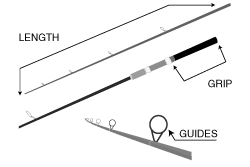Saltwater Rods
Use this guide to select the size and style rod that is right for your saltwater fishing outings.
How To Buy Saltwater Rods
Finding a rod to go saltwater fishing starts with three basic considerations: your experience, your preferred way of fishing and the type of fish you're after. You then have a choice of several styles of rods to get the job done.
How to buy saltwater rods
Types
There are two main types of rods--baitcasting and spinning. The type of rod you buy depends as much on the reel you buy as the type of fishing that you plan to do.
- Baitcasting rods
- Baitcasting rods take a baitcasting reel
- The reel and line are seated on top of the rod
- A trigger grip, a grip that looks simimlar to a trigger on a gun, lets you hold the rod securely while releasing the thumb bar/line release
- Spinning rods
- Spinning rods use a spinning wheel
- These rods have three main differences from casting rods:
- The reel hangs from the bottom of the reel seat, and the line guides are on the bottom as well
- The handle length is balanced against the rod's length
- Triggers are not used on spinning rods
Length & weight
Length and weight depend of the type of fish that you want to catch and your fishing style. Typically, the bigger the fish, the longer the cast so the longer the rod.
- Bottom-fishing
- Bottom-fishing rods run about 10 feet long and normally take 6- to 30-pound test line
- These rods also usually take baitcasting reels
- Boat
- Boat rods are smaller--5 1/2 to 6 feet--but they handle 50-130-pound test lines
- These also usually are for baitcasting reels
- Surfcasting
- Surfcasting rods come in lengths from 6 to 15 feet
- The length you need depends on how far you want to cast and what weight of lure you may be casting
- A 10-foot surfcasting rod will allow you to throw a 2- to 4-ounce lure 200 feet easily
- These rods work mainly with spinning reels
Action
- Action basically describes the way a rod is designed to perform when casting or reeling in a fish
- It also relates to the lure or bait you need and the strength of the reel that should be used
- The smaller the fish, the lighter the action that you'll need; the heavier the fish, the heavier the action that you should buy
- Most manufacturers use terms such as ultra-light, light, medium-heavy or heavy
Lure/Line weight
- Lure and line weight also play into rod selection. The heavier these are, the longer and heavier the pole that you should buy.
Materials/Construction
Most rods today are made from either graphite or fiberglass, or a composition of these two materials.
- Graphite
- Graphite has been refined over the years to provide lighter, more flexible rods that give you "sensitivity," a big plus in feeling when a fish begins to nibble on your bait
- Fiberglass
- Fiberglass provides more durability than graphite but sacrifices some sensitivity and is heavier than graphite
- Composites
- Composites give you the best of both graphite and fiberglass-- the durability of fiberglass combined with the lightweight, power and sensitivity of graphite
Grips

- Pistol grip
- A pistol grip is the shortest type of grip
- It is contoured to the shape of your hand with a hook for your index finger
- This hook helps in casting more accurately
- Triggerstick
- A longer triggerstick is used for two-handed, longer casts
- Materials
- Materials come in two general styles - cork or EVA foam
- Cork is a traditional material that has a good feel and solid grip
- EVA foam offers more durability because it is more resistant to temperature changes and water wear
Guides
- Line guides can be made of plastic, metal or ceramic, listed from least to best quality. These circles are positioned to the rod's shaft to control fishing line.
- In casting rods, line guides are positioned on top of the rod. They are smaller to reduce the play in the line and allow for easier casting and quicker retrieve.
- Spinning rods place the line guides on the rod's bottom. These guides get larger toward the base of the rod.
- The number of line guides is determined by the rod's length as well as by the quality of the rod
How to buy combos
- If you are new to fishing, combos are a great way to start. Manufacturers match the right reel with the right rod.
- All you need to do is determine the type of fishing that you want to do and then find the combo that best suits your needs
- Like anything else, the more features in a combo, as well as the more quality components, the more you will pay. A good combo, though, can provide a lifetime of fun.